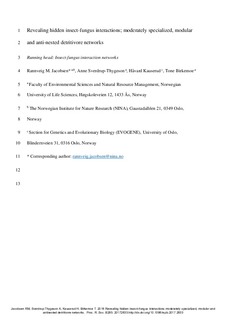| dc.contributor.author | Jacobsen, Rannveig Margrete | |
| dc.contributor.author | Sverdrup-Thygeson, Anne | |
| dc.contributor.author | Kauserud, Håvard | |
| dc.contributor.author | Birkemoe, Tone | |
| dc.date.accessioned | 2018-10-09T11:23:47Z | |
| dc.date.available | 2018-10-09T11:23:47Z | |
| dc.date.created | 2018-05-08T10:13:25Z | |
| dc.date.issued | 2018 | |
| dc.identifier.issn | 0962-8452 | |
| dc.identifier.uri | http://hdl.handle.net/11250/2567090 | |
| dc.description.abstract | Ecological networks are composed of interacting communities that influence ecosystem structure and function. Fungi are the driving force for ecosystem processes such as decomposition and carbon sequestration in terrestrial habitats, and are strongly influenced by interactions with invertebrates. Yet, interactions in detritivore communities have rarely been considered froma network perspective. In the present study, we analyse the interaction networks between three functional guilds of fungi and insects sampled from dead wood. Using DNA metabarcoding to identify fungi, we reveal a diversity of interactions differing in specificity in the detritivore networks, involving three guilds of fungi. Plant pathogenic fungi were relatively unspecialized in their interactions with insects inhabiting dead wood, while interactions between the insects and wood-decay fungi exhibited the highest degree of specialization, which was similar to estimates for animal-mediated seed dispersal networks in previous studies. The low degree of specialization for insect symbiont fungi was unexpected. In general, the pooled insect–fungus networks were significantly more specialized, more modular and less nested than randomized networks. Thus, the detritivore networks had an unusual anti-nested structure. Future studies might corroborate whether this is a common aspect of networks based on interactions with fungi, possibly owing to their often intense competition for substrate. | |
| dc.language.iso | eng | nb_NO |
| dc.rights | Attribution-NonCommercial-NoDerivatives 4.0 Internasjonal | * |
| dc.rights.uri | http://creativecommons.org/licenses/by-nc-nd/4.0/deed.no | * |
| dc.title | Revealing hidden insect–fungus interactions; moderately specialized, modular and anti-nested detritivore networks | nb_NO |
| dc.title.alternative | Revealing hidden insect–fungus interactions; moderately specialized, modular and anti-nested detritivore networks | nb_NO |
| dc.type | Journal article | nb_NO |
| dc.type | Peer reviewed | nb_NO |
| dc.description.version | acceptedVersion | |
| dc.subject.nsi | VDP::Zoologiske og botaniske fag: 480 | |
| dc.subject.nsi | VDP::Zoology and botany: 480 | |
| dc.source.volume | 285 | nb_NO |
| dc.source.journal | Proceedings of the Royal Society of London. Biological Sciences | nb_NO |
| dc.identifier.doi | 10.1098/rspb.2017.2833 | |
| dc.identifier.cristin | 1584055 | |
| cristin.unitcode | 192,14,0,0 | |
| cristin.unitname | Miljøvitenskap og naturforvaltning | |
| cristin.ispublished | true | |
| cristin.fulltext | postprint | |
| cristin.qualitycode | 2 | |

